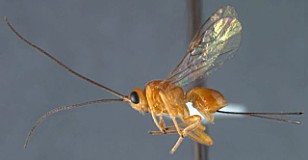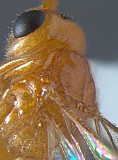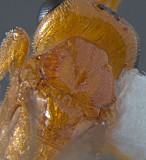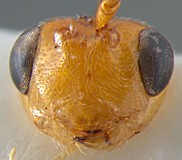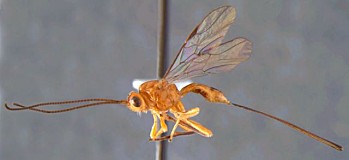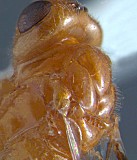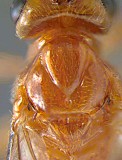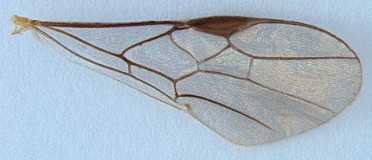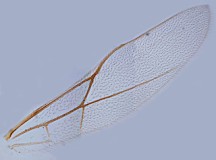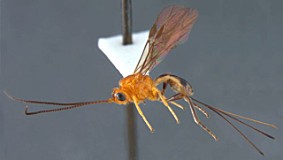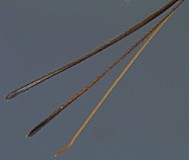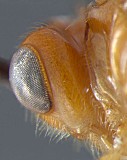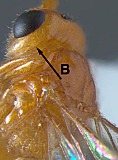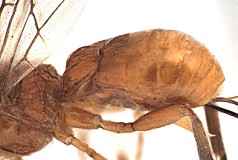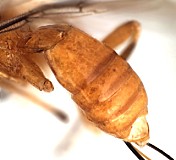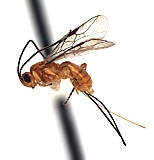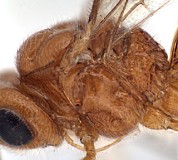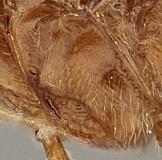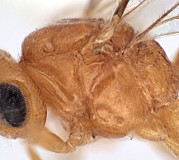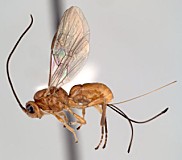Diachasmimorpha Viereck, 1913
Biosteres (Parasteres) Fischer, 1967: 3. Type species: Parasteres acidusae Fischer, 1967 [a junior subjective synonym of Diachasmimorpha tryoni (Cameron, 1911)]. Original designation.
Parasteres: Fischer 1971: 33 (change in rank). Synonymized under Biosteres by Wharton and Marsh (1978: 154) and under Diachasmimorpha by Wharton (1987: 62).
In many of the publications prior to 1988, the species of Diachasmimorpha were placed either in the genus Opius or in the genus Biosteres. Most of the species were included in the subgenus Chilotrichia of Biosteres by Fischer (1977, 1987). Wharton (1987: 62) removed Diachasmimorpha from synonymy and recognized it as a valid genus. Information on synonymies for the genus and the type species can be found in Wharton (1987: 62) and Wharton and Gilstrap (1983).
The name Parasteres continues to be used by some authors, for example as a subgenus of Diachasmimorpha (Yu et al. 2012), but we continue to treat D. tryoni and D. longicaudata in the same species group based in part on ovipositor morphology. We therefore do not treat Parasteres as valid, nor do we recognize subgenera under Diachasmimorpha at this time (as of 2015).
Diachasmimorpha, when treated in the strict sense, is clearly defined as monophyletic by the apically sinuate ovipositor (Wharton 1987, 1988), and the Indo-Australian group of species to which this definition applies (the longicaudata species group) has been recognized as distinctive since the work of Fullaway (1951). Van Achterberg and Maetô (1990) considerably broadened the definition of Diachasmimorpha by including the North American species mellea Gahan and (by implication) other species that do not have a sinuate ovipositor. The most recent treatments (Wharton 1997, van Achterberg 1999) have accepted this broader concept for Diachasmimorpha.
Both New and Old World species groups of Diachasmimorpha occur in several countries in Latin America, from Mexico to Argentina. For example, Diachasmimorpha longicaudata (Ashmead) and D. tryoni, both representatives of the Old World longicaudata species group (Wharton 1997), were established in various parts of Mexico during biological control programs directed against tephritid pests primarily in the genus Anastrepha. Females of the Old World species are readily distinguished from New World Diachasmimorpha because of the sinuate ovipositor (as noted above). The notauli are also more deeply incised posteriorly in the longicaudata species group, which facilitates identification of males in biological control and other tephritid pest management programs.
Considerably more information on species groups, species used in biological control, and some keys can be found in the Paroffit website, beginning with the Diachasmimorpha page [http://mx.speciesfile.org/projects/8/public/public_content/show/13236?content_template_id=88] and by following links to species pages.
Diachasmimorpha aino species group
This group contains two species, both from the Palaearctic region, that have not been sufficiently characterized to determine whether they belong in the Diachasmimorpha longicaudata species group, or whether they form a species group of their own. They are thus treated separately here. Diachasmimorpha aino occurs in Japan, where it has been reared from Euphranta in fruits of Prunus cerasus L. Diachasmimorpha feijeni has been reared from Bactrocera minax (Enderlein) from mandarin oranges (van Achterberg 1999).
Diachasmimorpha budrysi van Achterberg and Diachasmimorpha longicauda (Shestakov) are similarly difficult to place, but hosts are not yet recorded for these two species.
Diachasmimorpha carinata species group
This group contains three species: Diachasmimorpha carinata (Szépligeti), Diachasmimorpha brevistyli (Paoli), and Diachasmimorpha insignis (Granger). Two of the species (carinata and brevistyli) have been reared from ceratitine and dacine tephritids, with nearly all records published under the name giffardii, a junior subjective synonym of carinata. Silvestri (1913) provided the first biological information when he described this species and named it Hedylus giffardii. Information was subsequently published under the names Opius giffardii and Biosteres giffardii (Clausen et al. 1965, Wharton and Gilstrap 1983, Fischer 1987).
In general appearance, members of the Diachasmimorpha carinata species group very closely resemble species such as Diachasmimorpha longicaudata because of the carinate sculpture on the second metasomal segment (as in Figure 4 in the Description section above) and pale coloration. In the carinata species group, the apex of the ovipositor has small lobes and teeth but is otherwise straight rather than the distinctly sinuate ovipositor found in members of the Diachasmimorpha longicaudata species group.
Diachasmimorpha carinata and Diachasmimorpha brevistyli are virtually indistinguishable from one another, but brevistyli has been recorded only from Somalia whereas Diachasmimorpha carinata has been recorded from Kenya and Tanzania west through the Congo to Guinea, Sierra Leone, and Cameroon. It is possible that these two species are the same. The other species, Diachasmimorpha insignis, from Madagascar, does not have any host records, but its general similarity to carinata and brevistyli suggests a tephritid host.
Diachasmimorpha fullawayi species group
The only other Afrotropical species of Diachasmimorpha that has been reared from tephritids is Diachasmimorpha fullawayi (Silvestri). Diachasmimorpha fullawayi differs in several respects from the three species of the carinata group listed above. It is most easily separated from them by the absence of sculpture on the second metasomal tergum. However, this sculpture is sometimes weakly developed in males of carinata (and perhaps the other species as well). A more definitive character for separation is the presence of two small teeth along the midline at the apex of the clypeus in Diachasmimorpha fullawayi. These may be difficult to see, but are otherwise diagnostic for this species.
Diachasmimorpha longicaudata species group
The members of this species group that have been reared from tephritids include Diachasmimorpha albobalteata (Cameron), Diachasmimorpha hageni (Fullaway), Diachasmimorpha kraussii (Fullaway), Diachasmimorpha longicaudata (Ashmead), Diachasmimorpha dacusii (Cameron), Diachasmimorpha paeoniae (Tobias), and Diachasmimorpha tryoni (Cameron). This distinctive group, first recognized by Fullaway (1951), is readily defined by the apically sinuate ovipositor. The members of this group also have the notauli deeply impressed along their full length. Where known, the native hosts of most of these species are fruit-infesting tephritids in the genus Bactrocera Macquart. One species, Diachasmimorpha paeoniae, apparently occurs outside the range of Bactrocera in Siberia, and has been reared from Macrotrypeta ortalidina Portschinsky, a pest of flower buds. The remaining species are more tropical in distribution, ranging from Australia and India through China and the Pacific Islands to southern Japan. Both Diachasmimorpha longicaudata and Diachasmimorpha tryoni have been introduced to Hawaii, Florida, Latin America, and elsewhere, where they attack fruit-infesting tephritids in other genera such as Anastrepha Schiner and Ceratitis MacLeay. These two species are some of the most important and widely used species to date in tephritid biological control. They have also been reared from gall-making tephritids, though uncommonly (Duan and Messing, 1996). The Australian species Diachasmimorpha kraussii has also recently been introduced to Hawaii.
Three additional species that may belong here, Diachasmimorpha aino (Watanabe), Diachasmimorpha budrysi van Achterberg, and Diachasmimorpha feijeni van Achterberg, have yet to be thoroughly studied in terms of ovipositor morphology and so are treated separately as noted above.
The species of the longicaudata species group are identified largely on the basis of color pattern, distribution, and the presence or absence of carinate sculpture on the second metasomal segment. Color is unfortunately variable, and this is most obvious in Diachasmimorpha longicaudata, where color varieties have been described and even the genetic basis of a dark morph has been investigated. Differences in chemical composition of the Hagen’s glands of males may be useful for distinguishing cryptic species, but much work remains to be done. Diachasmimorpha longicaudata and Diachasmimorpha dacusii are distinguished largely by apparent differences in hosts but this situation needs further investigation. An enormous amount of literature has been published on species in this species group, especially Diachasmimorpha longicaudata, primarily in association with biological control programs, and often using the generic names Opius or Biosteres.
The following is a simplified key to species of the Diachasmimorpha longicaudata species group:
1. Metasomal tergum 2 with distinct carinae (see Fig. 4 under the description section)……………………………………2
— Metasomal tergum 2 smooth, polished, without distinct carinae (see Fig. 11 under the description section)………..….4
2. Eastern Russia…………………………………………………………………………..Diachasmimorpha paeoniae (Tobias)
— Indo-Australian…………………………………………………………….………………………………………………3
3. Propodeum dark………………………………………………………………………Diachasmimorpha albobalteata (Cameron)
— Propodeum pale (yellow to orange)……………..….Diachasmimorpha longicaudata (Ashmead) & D. dacusii (Cameron)
4. Metasoma entirely pale (yellow to orange)..…………………………………..…..Diachasmimorpha kraussii (Fullaway)
— Metasoma at least partly black…………….………………………………………………….……………..……………5
5. Occipital carina well developed laterally. Petiole and hind femur usually orange…….. Diachasmimorpha hageni (Fullaway)
— Occipital carina usually absent laterally except sometimes as a short ridge ventrally. Petiole
and hind femur predominantly to exclusively black……………………………..Diachasmimorpha tryoni (Cameron)
Diachasmimorpha mexicana species group
New World species have previously been referred to as the mexicana species group (Wharton 1997), a use we continue here. Wharton (1997) noted, however, that there were two subgroups distinguished in part on the basis of relative loss of the occipital carina. Further examination and discovery of additional species provides support for the two subgroups. One of these subgroups contains Diachasmimorpha juglandis (Muesebeck), Diachasmimorpha mellea (Gahan), and Diachasmimorpha sublaevis (Wharton). They have been variously reared as parasitoids of fruit-infesting tephritids in the genera Euphranta Loew, Rhagoletis Loew, and Myoleja Rondani. The occipital carina is generally better developed in this subgroup (usually readily visible laterally), the wings are hyaline, and the body is yellowish. As in the longicaudata species group, the anterior margin of the pronotum ventral-laterally is sharply excavated. The second subgroup contains Diachasmimorpha mexicana (Cameron), Diachasmimorpha sanguinea (Ashmead), and Diachasmimorpha hildagensis (Fischer). In all of these species, the occipital carina is greatly reduced, present only as a short spur ventrally near the mandible. These species also have infumate wings and the body tends to be orange rather than yellow. The anterior margin of the pronotum ventral-laterally is also more sinuate than abruptly excavated. There are no published host records for D. mexicana, but D. sanguinea has been reared from Zonosemata Benjamin. The species group is essentially Nearctic, ranging south into Mexico.
The origin of m-cu in the short second submarginal cell of the fore wing, the inclivous 1cu-a widely separated from 1M, the double node on the ovipositor, the venom apparatus, and the morphology of the clypeus and mandible all suggest a close relationship with both of the Old World species groups: the longicaudata species group and the carinata species group. The Diachasmimorpha mexicana species group differs from the longicaudata group in the more weakly developed notauli (best developed in mellea, where it is usually still visible as a faint impression posteriorly), the more posterior origin of RS+M (1RS/1M > 0.20), and the straight ovipositor. Thus, the mexicana species group, and in particular Diachasmimorpha mellea, Diachasmimorpha juglandis, and Diachasmimorpha sublaevis, is more similar to the carinata species group than to the longicaudata species group. Whether these similarities are sufficient to justify a sister-group relationship remains to be tested, since the most obvious traits involved are either plesiomorphic (straight ovipositor) or occur repeatedly within the Opiinae (reduced notauli).
The following is a simplified key to species of the Diachasmimorpha occurring in the New World:
1. Female (ovipositor clearly visible, extending well beyond apex of metasoma)………………………… 2
— Male…………………………………………………………………………………………………….. 10
2 (1) Ovipositor distinctly sinuate subapically (Fig. 28)…………………………………………………… 3
— Ovipositor straight or nearly so subapically (Fig. 29)………………………………………………….. 4
3 (2) Metasomal tergum 2 distinctly striate medially (Fig. 21). Occipital carina
well developed laterally, extending from base of mandible at least to mid eye height………….. longicaudata (Ashmead)
— Metasomal tergum 2 without striae or other sculpture (Fig. 22). Occipital
carina poorly developed to absent, not extending dorsally to lower eye margin………………….. tryoni (Cameron)
4 (2) Head dark, at least on dorsal half (Fig. 9)……………………………………………………………. 5
— Head pale (Figs 2, 4), yellow or orange except sometimes ocellar field dark………………………….. 7
5 (4) Ovipositor (total length) about 2.5 times longer than mesosoma. Notaulus extending anteriorly
to margin of mesoscutum (Figs 10, 27) …………………………………………………………………… 6
— Ovipositor (total length) less than 2.0 times longer than mesosoma. Notaulus rarely extending
anteriorly to margin of mesoscutum, usually terminating just before reaching margin (Fig. 32)…
………………………………………………………………………………………………………… norrbomi Wharton.
6 (5) Eye smaller than in Fig. 32, about 1.5-1.6 x longer than temple in lateral view………………….hildagensis (Fischer)
— Eye larger, 2.1-2.9 x longer than temple in lateral view (Fig. 33)…………………………………. martinalujai Wharton
7 (4) Wings darkly infumate (as in Figs 16, 36). Occipital carina represented at
most as in Fig 4, usually present as a short spur near mandible, otherwise absent……………… sanguinea (Ashmead)
Note: mexicana (Cameron) also keys here but is known only from the male,
which has a much smaller eye than that of sanguinea.
— Wings hyaline (Fig. 20). Occipital carina present laterally at least to lower margin
of eye, usually as in Fig. 2………………………………………………………………………………….. 8
8 (7) Metasomal tergum 2 distinctly striate medially (as in Fig. 21)……………………………….……….9
— Metasomal tergum 2 without striae or other sculpture (as in Fig. 22)…………………….. juglandis (Muesebeck)
9 (8, 13) Precoxal sulcus distinctly impressed, usually broad but very weakly
sculptured, nearly smooth (as in Fig. 38). Hosts are walnut husk flies in species of Juglans …….. sublaevis (Wharton)
— Precoxal sulcus distinctly impressed, broad, heavily sculptured: crenulate
to foveolate (as in Fig. 17 Hosts are other species of Rhagoletis in other fruits …………………. mellea (Gahan)
10 (1) Head black at least over dorsal half…..……………………………………………………………..11
— Head pale, yellow to orange except ocellar triangle sometimes black………………………………….13
11 (10) Eye in dorsal view as long as temple; eye in lateral view 1.3-1.4 x longer than temple…….. hildagensis (Fischer)
— Eye slightly larger, in dorsal view eye 1.4-1.9 x longer than temple, in lateral view
1.7-2.4 x longer than temple………………………………………………………………………………..12
12 (11) Notaulus extending anteriorly to margin of mesoscutum (Fig. 27)…………………….. martinalujai Wharton
— Notaulus rarely extending anteriorly to margin of mesoscutum, usually terminating just
before reaching margin (Fig. 35)………………………………………………………………… norrbomi Wharton.
13 (10) Metasomal tergum 2 striate medially (Fig. 21)……………………………………………..……..14
— Metasomal tergum 2 without striae or other sculpture (Fig. 22)…………………..……………..…….15
14 (13) Notauli deep posteriorly as it nears midpit (Fig. 19)………………………….…….. longicaudata (Ashmead)
— Notauli more shallow posteriorly as it nears midpit (Fig. 20)…………………………………..………8
15 (13) Metasomal terga mostly black (Fig. 22)………………………………………………… tryoni (Cameron)
— Metasoma with at least terga 3-5 pale: yellow to orange……………………………………………….16
16 (15) Wings hyaline…………………………………………………………………….…… juglandis (Muesebeck)
— Wings darkly infumate……………………………………………………………….…………………17
17 (16) Eye larger, about 1.3-1.5 x longer than temple in lateral view ………………………..sanguinea (Ashmead)
— Eye smaller, subequal to temple in lateral view (Fig. 35)…………………………….…….. mexicana (Cameron)

